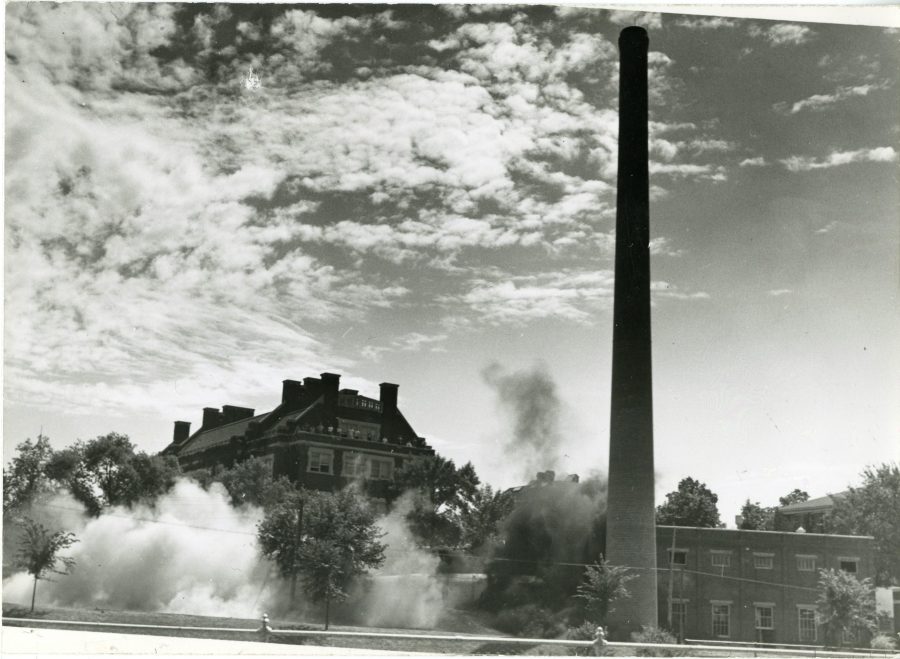The Transition
On September 26, 1941, The Carletonian published an article celebrating the construction of the college’s current smokestack. Some 80 years later, our picturesque smokestack will be shut off for the last time. This achievement reflects Carleton’s successful transition from steam heating to geothermal-based hot water heating.
As Phase 2 of Carleton’s Utility Master Plan nears completion, West Campus will transition away from steam heating, as happened for East Campus at the completion of Phase 1 in 2019. In lieu of steam heating, the college will now be heated by hot water from our geothermal heating system.
When baseline measurements began, the college emitted 22,000-24,000 metric tons of CO2 equivalents (CO2e) per year. In line with a trajectory to reach our target of zero emissions, the fiscal year 2020 estimates indicate that the college will emit around 17,000 CO2e this year.
According to Martha Larson, Carleton’s manager of Campus Energy and Sustainability, “Today, our carbon footprint is shrinking dramatically. We’re moving more from fossil fuels to the earth’s capability to help us heat our campus.” The swift transition from natural gas-based steam to hot-water-based heating has been integral to this process. Compared to the previous natural gas methods, “we’re now using more of the earth’s capabilities to heat campus,” Larson told The Carletonian.
Logistically, it was first imagined that geothermal energy would be best applied to a single building. The example set by Ball State University, with their campus-wide geothermal energy system, set the tone for a much broader approach; Larson noted that “we realized that geothermal could be applied to a campus district energy system.” Larson also said that changing to geothermal heat poses a threefold benefit: “the change serves our demand for the foreseeable future, it reduces our operating costs, and it reduces our carbon emissions.”
This heating transition represents dramatic net-savings in Carleton’s energy consumption. Larson told The Carletonian, “We will reduce our natural gas consumption dramatically, but because the geothermal heat pump is an electric device, we will increase our electricity use.” She added, “The net difference was a 44% reduction in total British Thermal Units for the fiscal year 2020.” British Thermal Units (BTU) are a measurement of heat energy—one BTU represents the amount of heat required to raise the temperature of one pound of water by one degree Fahrenheit.
Larson did add that the uptick in electricity (11% for this fiscal year) may have been slightly deflated due to the lack of students on campus this past spring. Nonetheless, a net savings in emissions is still projected. Larson suggests that the true effects of the geothermal system will be best highlighted during a regular academic year.
Having the college heating system skew toward electricity proves quite advantageous. Larson told The Carletonian, “the exciting thing for Carleton is that it is much easier for us to engage with renewable technologies in terms of our electricity than it is for natural gas.” She pointed to the two wind turbines as a strong, established example of “greening up” our campus electricity. Larson explains, “There are lots of irons in the fire about what’s next [for similar initiatives].” Additionally, the college receives much of its energy from Xcel Energy, a company that has also pledged carbon neutrality by 2050. “The fact that our electric company aligns with our goals is extremely helpful.”
The Symbolism
While the old smokestack is not going anywhere, its active role will be filled by a significantly smaller existing smokestack on the northern end of Facilities. Concerning the new smokestack itself, there’s a lot to unpack. Larson commented, “There’s a lot of symbolism in this new transition.” The new stack is a mere fraction of its predecessor.
The smokestack in place prior to 1941 emitted exhaust from the coal-burning power grid. That stack was replaced by the active one, which The Carletonian called “35 feet higher, 2 feet larger.” The new stack represented a shift from coal to natural gas. “The old stack was built in an era of growth when Carleton was expanding,” Larson said. Sentiments from 1941 echo this, as The Carletonian then wrote, “Westward and upward the course of empire…”
While the Carleton community has only continued to grow, we are now doing so more sustainably. Our new smokestack symbolizes our ongoing movement as a college away from fossil fuels altogether. Carleton has a goal to become carbon neutral by 2050. This commitment was first made by President Robert Oden in 2007, as part of the American College & University Presidents’ Climate Commitment. Current President Steven Poskanzer renewed this commitment in 2010. Our mid-century goal of carbon neutrality also inspired the 2011 Climate Action Plan. As Larson notes, for the fiscal year 2020, the college is on track to hit this goal.
President Poskanzer echoed this sentiment: “I am very pleased that we have made substantial progress towards carbon neutrality with initiatives in recent years such as geothermal wells and the conversion to more energy-efficient heating/cooling. But we want to sustain this momentum by identifying and implementing next steps that will further drive down our carbon footprint. Our work here is not yet done, as individuals and as an institution.”










